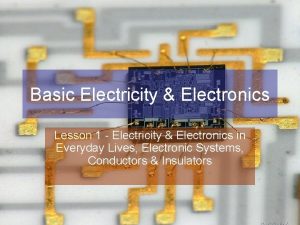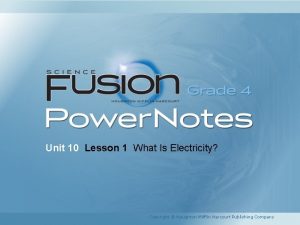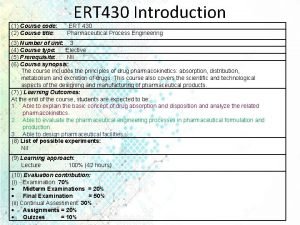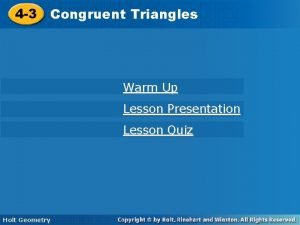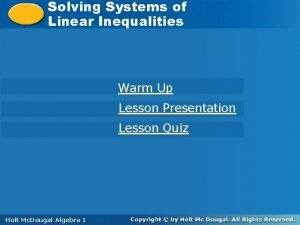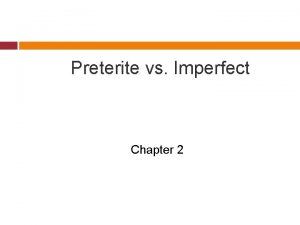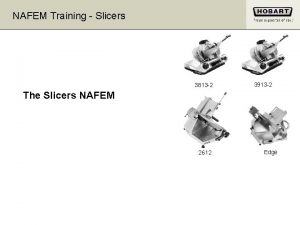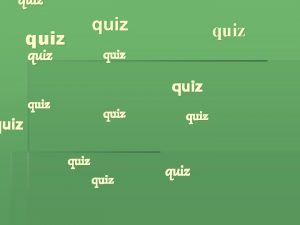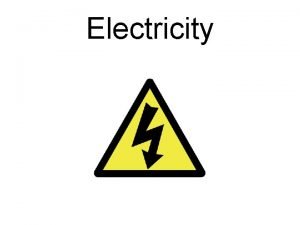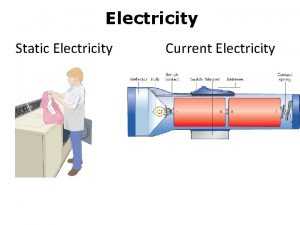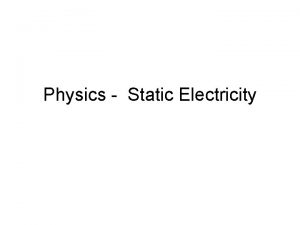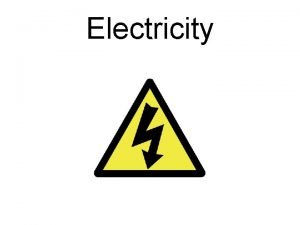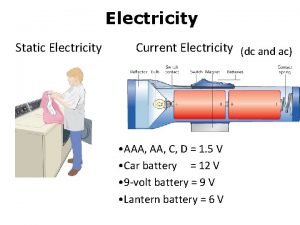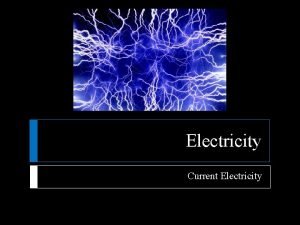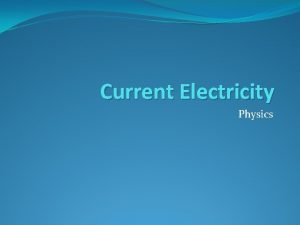ELECTRICITY WEEK 7 LESSON 1 3913 QUIZ 1
















- Slides: 16

ELECTRICITY WEEK 7 LESSON 1 3/9/13

QUIZ 1. What are the charged parts of the atom? Proton +, Electron - 2. What causes an object to gain a charge? Removal of gain of electrons 3. What is the numerical charge on an electron? -1. 602 x 10 -19 C 4. Can an object (plastic pole) with a positive charge attract small pieces of paper? How and Why? Yes, the positive charge on the object will induce a –ve charge on one side of the paper, hence attracting it to the pole 5. Name a conductor and an insulator Metal, plastic or glass

Lightning • The exact method with which a storm gathers a charge is not fully understood • One theory is that the water droplets and ice crystals contained in the cloud collide with each other and this causes the electrons to be “knocked off” • The electrons that are knocked off gather at the bottom of the cloud and the newly positively charged ions are carried to the top of the cloud by rising moisture. • This causes a charge separation, positive at the top of the cloud and positive at the top • This causes an electric field to form, as it intensifies it induces the electrons in the earths surface to repel deeper into the earths surface, hence creating a positively charged earth surface. • When the electric field gets very strong, the air begins to ionise (breakdown). This ionisation of the air molecules allows free movement of electrons, these electrons are now free to carry a charge http: //www. youtube. com/watch? v=0 XXwn 7 DBi. Z 8

The charge from the ground rushes up, generally through the highest point on the ground to meet the current coming down from the cloud

ELECTRIC FORCES The force between two charges is a proportional to the product of the two charges and inversely proportional to the square of the distance between them Coulombs Law F = kq 1 q 2 r 2 F = Force in N k = proportionality constant 9. 0 x 109 N m 2 C-2 q 1 = charge one in C q 2 = charge two in C r = distance between charges in metres

The force exerted by two 1 coulomb charges situated 1 m apart is a force of 1010 Newtons. That is equivalent to the weight of approx 10 battleships! Therefore 1 C of charge is a huge amount of charge. As you can see, electrical forces are huge!

Neutron Star The latter stages of the collapse of a giant star is the only time that gravitational forces can overwhelm the electrical forces between atoms. Electrons are forced into the nucleus by huge gravitational forces where they combine to form neutrons. This forms an extremely dense core made up of neutrons, hence the name the Neutron Star


ELECTRIC FIELDS To calculate all of the forces on a charged object is impractical and would take to long to do. So scientists use the concept of an electric field. Around any charged object there is a region of space in which a charge would experience a force The force this charge experiences is said to be the electric field Electric field has both direction and strength so is a vector quantity

E=F q E = Electric Force per Coulomb of charge (N C-1) F = Force in N q = Charge in C

An electric field is shown by lines which represent the direction of the field. The closer the lines, the stronger the field

Two positive charges A positive and negative Charge

Parallel oppositely charged plates

Complete the following questions SET 14; Electric Charges and Fields Pages 142 and 143 in STAWA Exploring Physics

QUIZ 1. Define electric force The amount of attraction or repulsion between two charged objects 2. What symbol are charges given? Q 3. If two charges are the same, what happens to those charges? each other 4. The force between two charges. They canwill berepulse calculated using the following equation F = k Q 1 Q 2 r 2 What two things affect the amount of Force between 2 charges? The size of the charge and the distance between them 5. Draw the electric fields of two positive charges and a positive and negative charge

 Static electricity and current electricity
Static electricity and current electricity Current electricity
Current electricity Magnetism vocabulary
Magnetism vocabulary Week by week plans for documenting children's development
Week by week plans for documenting children's development Chapter 1 lesson 1 your total health answer key
Chapter 1 lesson 1 your total health answer key Nr 601 week 7 reflection post
Nr 601 week 7 reflection post Andythelwell
Andythelwell Lesson 1 what is electricity
Lesson 1 what is electricity This weeks lesson
This weeks lesson Lesson plan for revision week
Lesson plan for revision week Last week's lesson
Last week's lesson Every quiz has been easy. therefore the quiz will be easy
Every quiz has been easy. therefore the quiz will be easy Every quiz has been easy. therefore the quiz will be easy
Every quiz has been easy. therefore the quiz will be easy Quiz 4-2 congruent triangles
Quiz 4-2 congruent triangles Lesson quiz 16-1 monetary policy
Lesson quiz 16-1 monetary policy Lesson 1 the cold war begins
Lesson 1 the cold war begins 4-5 lesson quiz systems of linear inequalities
4-5 lesson quiz systems of linear inequalities






